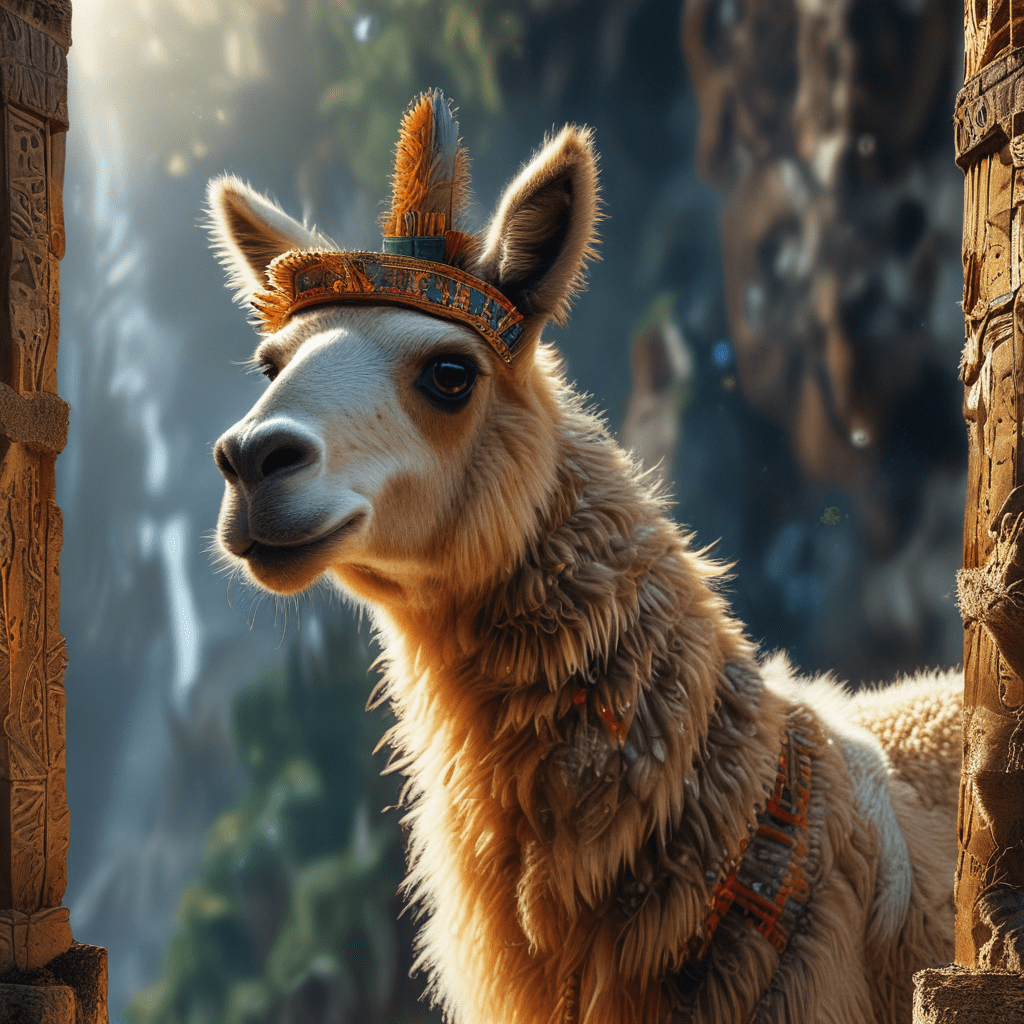The Myth of the Incan Llama: Sacred Animal of the Andes
The llama, a gentle and hardy member of the camelid family, holds a special place in the hearts and minds of the Andean people. For centuries, the llama has been more than just a domesticated animal; it has been revered as a sacred creature, deeply intertwined with the mythology, religion, and culture of the ancient Incan civilization.
In the realm of Inca mythology, the llama is not merely a mythical creature but a symbol of the divine, representing the connection between the earthly and the celestial. Its significance transcends the boundaries of practical use, transforming the llama into a powerful symbol of life, sacrifice, and the spiritual realm.
The Llama in Incan Mythology and Religion
In the intricate tapestry of Incan mythology, the llama represents the embodiment of the divine spirit, Pachamama, the Earth Mother. This sacred connection is rooted in the llama's enduring role as a vital source of sustenance and resource, fueling the Incan way of life. The Inca believed that Pachamama manifested through the llama, bestowing blessings on those who honored and respected the animal.
The Incan people believed that the llama was a gift from the gods, a symbol of their generosity and favor. The animal was considered to be a bringer of good fortune, and its presence was seen as a sign of divine protection and prosperity. The llama was also associated with the sun god, Inti, as its fleece was often dyed with the colors of the sun, further highlighting the animal's sacred association with the celestial realm.
The Llama as a Symbol of Sacrifice and Offering
The llama's sacred status also made it a central part of Incan ritual practices, especially in the realm of sacrifice. The Incas believed that offering a llama to the gods would appease them and bring about good fortune. The act of sacrifice was seen as a way to honor the divine beings, express gratitude, and ensure the continued well-being of the community.
The practice of llama sacrifice was not solely reserved for large ceremonies. Even everyday activities like planting crops might involve symbolic offerings of llama wool or small amounts of llama blood, demonstrating the deep integration of the llama into the fabric of Incan life.
The Llama as a Source of Sustenance and Wealth
Beyond its spiritual significance, the llama was an indispensable part of the Incan economy. It served as a vital source of sustenance, providing both meat and milk for the people. Its fleece was used to create warm clothing, blankets, and textiles, demonstrating the animal's practical value to the Incan civilization.
The llama's strength and endurance made it a valuable pack animal, aiding in the transportation of goods, crops, and even people across the rugged Andean terrain. This ability to navigate challenging environments contributed significantly to the Incan empire's ability to expand and thrive.
The Llama in Incan Rituals and Ceremonies
Incan rituals and ceremonies were infused with the presence of the llama, showcasing its central role in spiritual and societal life. Llama sacrifices were often conducted during important festivals, such as the Inti Raymi, the festival of the sun god, where the llama's blood was offered as a symbol of renewal and fertility.
Llamas were also used in ceremonies dedicated to Pachamama, the Earth Mother. These rituals often involved offerings of llama wool, llama blood, and even live llamas, seeking to appease the goddess and ensure bountiful harvests. The llama's presence in these rituals reinforced its connection to the natural world and its role as a mediator between humans and the divine.
The Llamas: The Inca’s “Gold”
The llama's value to the Inca went far beyond its practical uses. Its fleece, known for its warmth and durability, was more than just clothing. It was a symbol of wealth and status. The finest llama wool, often dyed in vibrant colors, was used for the garments of the Inca nobility. The llama's fleece was even traded as currency, demonstrating its economic and societal importance.
The Incas understood the value of llama wool, and they put a lot of effort into ensuring that their animals produced the best possible fleece. They developed techniques for breeding and shearing their llamas, and they even created special dyes to color the wool in a variety of ways. The llama's fleece was a source of pride for the Incas, and it played an important role in their economy and culture.
The Llama as a Symbol of Andean Identity
The llama's connection to the Inca civilization has transcended time and continues to resonate deeply within Andean culture today. This enduring bond highlights the llama's enduring prominence as a symbol of Andean identity. It represents the resilience, adaptability, and deep connection to the land that defines the Andean people.
Even in modern times, the llama remains an integral part of Andean life. It represents a cultural heritage passed down through generations, sustaining a connection to ancestral traditions. The llama is a symbol of the Andean people's spirit, their strong connection to the land, and their unwavering resilience.
The Role of the Llama in Incan Art and Architecture
The llama's importance in Incan life is evident in the vibrant tapestry of Incan art and architecture. The image of the llama appears in various forms, from intricate ceramic designs to monumental stone carvings. These artistic representations highlight the llama’s significance in both spiritual and practical contexts.
Ceremonial structures, such as temples and palaces, often featured llama motifs, signifying the animal's connection to the divine. Llama designs were also incorporated into textiles, jewelry, and other decorative items, reflecting its cultural and symbolic significance within Incan society. The llama’s presence in Incan art and architecture serves as a testament to its enduring importance within the civilization.
The Llama as a Guide and Companion in the Afterlife
The Incan belief system extended the llama’s role beyond earthly life, incorporating the animal into their concept of the afterlife. The llama was seen as a guide and companion in the spiritual realm, accompanying the deceased to the next life. This belief is reflected in burial practices, where llamas were sometimes sacrificed and buried alongside the deceased, symbolizing their continued companionship in the afterlife.
The Incas believed that the llama's gentle nature and its connection to the Earth Mother, Pachamama, made it a suitable guide for the soul's journey into the spiritual realm. This belief further underscored the llama's profound spiritual importance within Incan society.
Theories on the Origin of the Llama Myth
The llama's profound symbolism within Incan mythology has sparked various theories regarding its origins. Some scholars argue that the llama's sacred status stemmed from its practical importance in Incan life. Its role as a source of sustenance, transportation, and wealth could have led to its deification over time.
Others suggest that the llama's connection to the Earth Mother, Pachamama, might have been influenced by the animal's association with fertility and the cycle of life. The llama's ability to provide sustenance and support could have been seen as a manifestation of Pachamama's nurturing power. Regardless of its origin, the llama's myth reflects the Incan people's deep reverence for the natural world and their interconnectedness with it.
FAQ
What is the role of the llama in Andean culture?
The llama plays a significant role in Andean culture, symbolizing resilience, adaptability, and a deep connection to the land. It represents a cultural heritage passed down through generations, sustaining a connection to ancestral traditions.
What is the significance of llama sacrifices in Incan rituals?
Llama sacrifices were a crucial part of Incan rituals, signifying a connection between the earthly and the celestial. They were seen as a way to appease the gods, express gratitude, and ensure the continued well-being of the community.
Why was the llama considered sacred by the Incas?
The llama’s sacred status stemmed from its connection to the Earth Mother, Pachamama, its role as a vital source of sustenance, and its association with the divine realm.
What are some examples of llama motifs in Incan art and architecture?
Llama motifs are found in Incan ceramic designs, stone carvings, textiles, jewelry, and even ceremonial structures like temples and palaces.
What are some theories about the origin of the llama myth?
Some theories suggest that the llama’s sacred status stemmed from its practical importance, while others point to its association with fertility and the Earth Mother.



